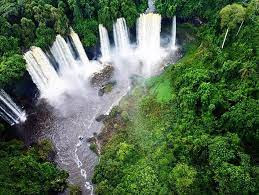Introduction:
Waterfalls have captivated the human imagination for centuries, their majestic beauty and awe-inspiring power leaving us in awe. This essay delves into the history of waterfalls, exploring their geological formation, cultural significance, and the fascination they evoke in people around the world. From their ancient origins to their enduring allure, waterfalls continue to mesmerize us with their timeless beauty.
I. Geological Formation:
1. The Power of Water:
Waterfalls are formed through the relentless force of flowing water, shaping the Earth's surface over millions of years. Erosion, tectonic movements, and varying geological structures contribute to the creation of waterfalls in diverse landscapes.
2. The Role of Rivers and Streams:
Waterfalls are most commonly found along rivers and streams, where the water encounters a sudden drop in elevation. These drops create cascades of water that tumble over rocks, creating breathtaking displays of nature's power.
II. Cultural Significance:
1. Spiritual and Mythological Beliefs:
Throughout history, waterfalls have held deep spiritual significance in various cultures. They have been revered as sacred sites, associated with gods and goddesses, and believed to possess healing properties. Waterfalls often feature prominently in myths, legends, and religious ceremonies.
2. Symbolism and Inspiration:
Waterfalls symbolize purity, life force, and the relentless flow of time. Artists, writers, and poets have drawn inspiration from their grandeur, using them as metaphors for emotions, transitions, and the cyclical nature of life.
III. Famous Waterfalls Around the World:
1. Niagara Falls, North America:
Niagara Falls, located on the border of the United States and Canada, is one of the most famous waterfalls globally, attracting millions of visitors each year. Its sheer size and thunderous roar make it a natural wonder and a symbol of natural beauty.
2. Victoria Falls, Africa:
Victoria Falls, located on the Zambezi River between Zambia and Zimbabwe, is one of the largest and most awe-inspiring waterfalls in the world. Known as "The Smoke that Thunders," it is a UNESCO World Heritage Site and a popular tourist destination.
3. Iguazu Falls, South America:
Iguazu Falls, situated on the border of Argentina and Brazil, is a collection of stunning waterfalls spread across a vast area of tropical rainforest. Its cascades, surrounded by lush greenery, create a mesmerizing spectacle and support a unique ecosystem.
IV. Waterfalls in Mythology and Folklore:
1. Seljalandsfoss, Iceland:
Seljalandsfoss, known for its picturesque beauty and accessibility, holds a prominent place in Icelandic folklore. It is said to be a dwelling place for elves and hidden creatures, adding an air of mysticism to its already enchanting allure.
2. Angel Falls, Venezuela:
Angel Falls, the world's highest uninterrupted waterfall, holds great cultural significance to the indigenous Pemon people of Venezuela. It is named after Jimmy Angel, an American aviator who first publicized its existence to the world.
V. Conservation and Environmental Importance:
1. Ecosystems and Biodiversity:
Waterfalls provide unique habitats for a wide array of plant and animal species. The surrounding ecosystems rely on the moisture and microclimates created by the falling water, supporting diverse flora and fauna.
2. Threats and Conservation Efforts:
Human activities, such as deforestation, pollution, and climate change, pose significant threats to waterfalls and their ecosystems. Conservation organizations and local communities are working together to protect and preserve these natural wonders through initiatives focused on habitat restoration, education, and sustainable tourism.
VI. The Power of Waterfalls as Tourist Attractions:
1. Tourism and Economic Impact:
Waterfalls have
become popular tourist destinations, attracting visitors from around the world. Their natural beauty and recreational opportunities contribute to local economies, providing employment and supporting infrastructure development.
2. Responsible Tourism:
Responsible tourism practices are crucial for preserving the integrity of waterfalls and their surrounding environments. Balancing visitor access with conservation efforts ensures the long-term sustainability and enjoyment of these natural wonders.
Conclusion:
Waterfalls stand as enduring symbols of nature's power, beauty, and mystery. From their geological formation to their cultural significance and ecological importance, waterfalls continue to fascinate and inspire people across generations. As we marvel at their splendor, let us also embrace the responsibility to protect and preserve these natural treasures for future generations to cherish and enjoy.


Post a Comment